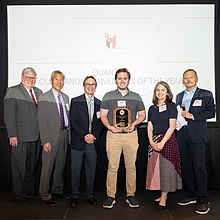Gorshkov, Gullans Part of Team Honored With Invention of the Year

Two quantum experts with adjunct appointments in the University of Maryland Institute for Advanced Computer Studies are part of a team recently honored for developing a new method to count particles of light—known as photons—without destroying them.
Alexey Gorshkov and Michael J. Gullans—working with other researchers associated with the Joint Center for Quantum Information and Computer Science (QuICS) and Joint Quantum Institute (JQI)—won a University of Maryland Invention of the Year award in the quantum category.
Gorshkov and Gullans are both physicists at the National Institute of Standards and Technology (NIST), Fellows in QuICS, and senior investigators in the NSF Institute for Robust Quantum Simulation (RQS), where they each lead a different research challenge.
"While our invention is theoretical, if realized in practice, high-fidelity non-destructive single-photon counters would have numerous applications in imaging, quantum computing, and quantum networking," explains Gorshkov.
The team’s approach uses an organized sheet of atoms to absorb photons temporarily and serve as an intermediary. Probing the atoms allows the number of photons that were absorbed to be measured before they are eventually emitted back out of the atoms.
This work was detailed in a paperpublished in 2022.
“Photons are hard to work with and don't typically interact with one another, but atoms are easy to work with, and you can make them interact,” explains Chris Fechisin (holding plaque in photo), the paper’s lead author who is a third-year physics doctoral student in QuICS. “By taking information stored in photons—which don't easily talk to each other and are hard to pin down—you can convert the photonic data into atomic data.”
The other co-inventors of the non-destructive photon counting protocol include Trey Porto, a physicist at NIST and JQI, adjunct professor in physics at UMD, and senior investigator at RQS; Steve Rolston, a UMD professor of physics, JQI researcher and senior investigator at RQS; Kunal Sharma, a former QuICS Hartree Postdoctoral Fellow who now works at IBM Research; and Przemyslaw Bienias, a former QuICS postdoctoral researcher who now works at Amazon Web Services.
In the paper, the researchers describe the procedure and outline what is needed from the atoms so that they and the photons can be quantum mechanically tied together and measured, without destroying the photons.
The approach works because when atoms in the array absorb light, they can be made to cycle between quantum states at different rates that depend on how many photons have been absorbed. In their proposal, the team described how a series of measurements can home in on the frequency the atoms are cycling at, identifying the corresponding number of photons. After the count is obtained, the atoms can emit the photons. The paper also includes an analysis of how to choose an efficient set of measurements to reliably identify the correct cycling frequency.
“The protocol works in a way that's kind of elegant,” Fechisin says. “You have information stored in these unwieldy photons, you turn it into atomic excitations over which you have a much greater degree of control, and then you just very neatly get this signal, which contains exactly the information that you want.”
Fechisin represented the team and accepted the award at the annual Innovate Maryland event on April 29. Recognized along with three winners from other categories, the technology was one of 154 inventions disclosed at UMD this past year.
In speaking at the event, UMD Vice President for Research Gregory F. Ball acknowledged all the inventors in this year’s competition.
“Each of tonight’s nominees for Invention of the Year started with that spark of an idea that was allowed to grow and evolve with the help of our robust research enterprise, which we all contribute to and improve on a daily basis,” he said. “I firmly believe that no grand challenge is too daunting for our world-class researchers to confront head-on and work toward a solution.”
—This story was adapted from an article by the JQI communications group
